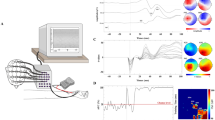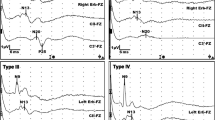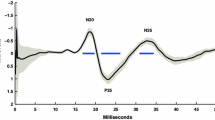Abstract
Objective: To evaluate the outcome of children 1 and 5 years after severe brain injury (Glasgow Coma Score < 8) using a functional measure [Glasgow Outcome Scale (GOS)] and a health status measure (the Torrance Health State (HUI:1)) and to determine the ability of somatosensory evoked potentials (SEPs) to predict these long-term outcomes. Design: Prospective study. Setting: A 16-bed paediatric intensive care unit in a tertiary children's hospital. Patients and participants: 105 children with severe brain injury. Interventions: SEPs were recorded once in the first week after admission. Outcome was assessed 1 and 5 years after injury using the GOS and at 5 years after injury using HUI:1. Measurements and results: At 5 years, using the GOS, 46 (43.8 %) children had a good outcome, 10 (9.5 %) were moderately disabled, 2 (1.9 %) severely disabled, 3 (2.9 %) vegetative and 44 (41.9 %) had died. At 5 years, 17 of 40 (42.5 %) survivors from 1 year had changed outcomes: 12 had improved, 3 had worsened and 2 had died. For a normal SEP, positive predictive power was 85.4 %, sensitivity 62.5 %, specificity 87.8 %, negative predictive power 67.2 % and the positive likelihood ratio was 5.1. For bilaterally absent responses, positive predictive power was 90.9 %, sensitivity 61.2 %, specificity 94.6 %, negative predictive power 73.6 % and the positive likelihood ratio was 11.4. Outcomes using HUI:1 were: 30 (28.6 %) had a good quality of life, 21 (20.0 %) had a moderate quality of life, 7 (6.7 %) a poor quality, 44 died (41.9 %) and 3 (2.9 %) survived in a state deemed worse than death. For a normal SEP, positive predictive power was 85.4 %, sensitivity 68.6 %, specificity 88.9 %, negative predictive power 75.0 % and the positive likelihood ratio was 6.2. For bilaterally absent responses, positive predictive power was 93.9 %, sensitivity 57.4 %, specificity 96.1 %, negative predictive power 68.1 % and the positive likelihood ratio was 14.6. Conclusion: The outcome for children with severe brain injury should be assessed 5 years after injury because important changes occur between 1 year and 5 years. Differences exist between outcomes assessed using the GOS and HUI:1 as they measure slightly different aspects of function. Consideration should therefore be given to using both measures. SEPs are excellent predictors of long-term outcome measured by either the GOS or the HUI:1.
Similar content being viewed by others
Author information
Authors and Affiliations
Additional information
Received: 22 January 1999 Accepted: 19 April 1999
Rights and permissions
About this article
Cite this article
Carter, B., Taylor, A. & Butt, W. Severe brain injury in children: long-term outcome and its prediction using somatosensory evoked potentials (SEPs). Intensive Care Med 25, 722–728 (1999). https://doi.org/10.1007/s001340050936
Issue Date:
DOI: https://doi.org/10.1007/s001340050936




